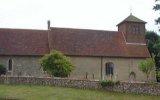
Great Easton

 |
Great Easton |
 |
THE HISTORY OF GREAT EASTON
The place name Great Easton, like that of Little Easton, stems from the Manor of Eistanes, as recorded in Domesday Book 1086, and variously spelt at Eastuna (1119), Eystaynes (1248) and in 1518, recorded as Est Stanes at the Hyll. It is said to translate as Aega’s stone.This village extends eastwards from the Chelmer valley, including Millend Green and Duton Hill.
There are some fine timbered houses, with ornamental plasterwork, decorated bargeboards and Tudor chimneys. P.H. Reaney’s Place Names of Essex shows that many of them have names traceable to medieval farmers: Blamsters Hall from William de Blauminister (1280); Hide End Farm from Richard ate Hyde (1319); Hill Farm from John ate hill (1319); Andrews from John Andrew (1381); Kirbys Farm from Nigel Kirkeby (1382); Maysland from John le May (1319); Nicholls Fram from John Necol (1381); Welches Farm from Richard Welche (1363); Wolseys Farm from Richard Wolcy (1421); Little Cambridge from Stephen de Cantebrigg (1342); Dew Wood from Maud Douwod (1363)/
Other local place names include Breach, so named 1777, Duton Hill which was Dewton in 1570. Gallow green as Galloughgrene in 1505. Millend Green as Mill Green in 1777, Muskhams as Muscombs 1777 and Radleys End so called in 1777.
The Parish Church of St John & St Giles has a Norman nave, a 13th century chancel and Roman tiles built into its walls. Pevsner describes the church tower as ‘a jumble when seen from the west, the west wall carried up in brick to support a bell-turret of circa 1800, the turret replaced by a short tower in 1928 by F.W. Chancellor in a darker brick with black diapers and a low pyramidal roof’. The remainder of the church was restored in 1899, with further 20th century additions, so that this church represents a fascinating mixture of change over many centuries.
Easton Hall is a timber-framed building of 15th and 16th century date with a medieval barn and nearby the remains of a motte and bailey with a moat, a Scheduled Monument. Pevsner describes the other fine 16th and 17th century houses of the village, but also picks out some interesting modern buildings such as the remodelled Croys Grange and New Farm.
The Rural Areas Local Plan for Great Easton in 1986 described the village as lying on the eastern slope of Chelmer Valley a couple of miles from Great Dunmow – the valley is an Area of Special Landscape Value. The village is surrounded by intensively cultivated arable land, Grade 3 on the valley sides and grade 2 on the higher plateau at the eastern end of village. There are attractive groups of trees like Little Bullens to the north, some nice hedges and protected lanes along the Chelmer valley and at Cox Hill. The historic core is round the church at top of hill, with many listed buildings, trees, churchyard, greens and archaeological features – this is a designated Conservation Area.
Sources
Bettley,
J. & Pevsner, N. The Buildings of
England: Essex (1954,
new edition 2007).
Mee, A. , The King’s England: Essex (1966).
Reaney, P.H. The Place Names of Essex.
Great Easton Rural Areas Local Plan (in Saffron Walden Town Library)